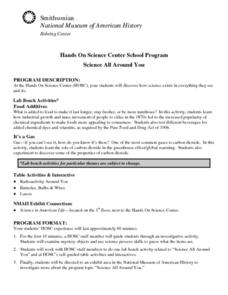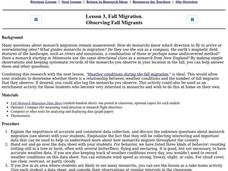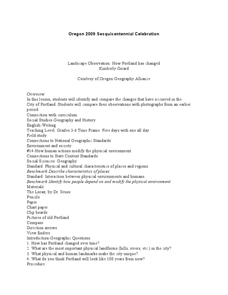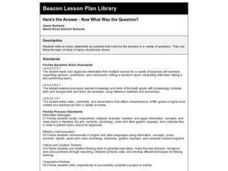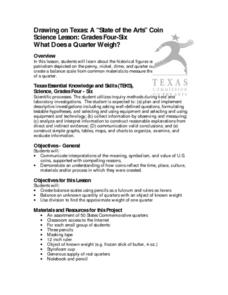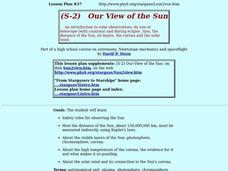Curated OER
Endosymbiosis: A Friend Within
Students research the ecological principle of symbiosis. Using a microscope, students observe the relationship of mutualism between termites and flagellates. Students examine a live termite and protozoans. They discuss the principles...
Curated OER
Remote Possibilities
Students collect data and analyze the data using a graph. In this statistics lesson, students use combinations and theoretical and experimental probability to analyze their data. They observe a remote controlled robot as they collect data.
Curated OER
Science All Around You
Students visit and explore a Hands On Science Center (HOSC). They participate in a variety of self-guided table exercises and observe as scientists demonstrate various scientific principles.
Curated OER
Poetry
Fifth graders read several poems by famous poets and identify what about their style makes them unique. They then analyze and compare poetic style, use of forms and themes. Next, 5th graders investigate and collect different examples of...
Curated OER
Science: Identifying Properties of Matter
Students observe a demonstration of the the three forms of matter - air, water, and solids - in plastic bags. After discussing the properties, they transfer them to a Venn diagram. Finally, students identify five items in the classroom...
Curated OER
Color
Students study the elements of color in paint and light. In this color science lesson, students discuss colors in their world, white light, and rainbows. Students mix three primary paint colors to make various secondary colors. Students...
Curated OER
Sharing Love
Young scholars explore the expansion of love. They read a story about showing love and sing a song. Students draw a picture describing love. In a group activity, young scholars participate in a "Greetings Dance." Students may bring...
Curated OER
Do Plants Eat?
Students explain that photosynthesis is a process that plants use to convert light energy into glucose. They summarize photosynthesis as a chemical process in which the plant uses carbon dioxide and water to form glucose and oxygen.
Curated OER
What Shape Is It?
Young scholars predict the shape of an unknown object by bouncing a ball on it. In this physics lesson, students relate this activity to how dolphins use echo-location to navigate. They analyze their lab result and discuss findings.
Curated OER
Observing Fall Migrants
Students keep a detailed data collection log of the different types of monarch behavior. They track the weather conditions daily and link it to the migration of the monarchs. They summarize their data using either a graph or a computer...
Curated OER
Artifacts: What Am I?
Pupils practice simple Japanese expressions. They explore the information available from artifacts. Groups of students attempt to figure out other groups culture by examining a series of artifacts in a paper bag.
Curated OER
Landscape Observation: How Portland Has Changed
Students read The Lorax and discuss how populations change the environment. Using given photos, students use a Venn Diagram to compare and contrast the Portland of yesterday to present day Portland. They write a comparison paper and...
Curated OER
The Heat is On
Third graders experiment with heat through investigations. They rub objects together and compare the relative differences in the amount of heat given off. They write in their journals about the results they find.
Curated OER
Here's the Answer - Now What Was the Question?
Fifth graders write as many statements as possible that could be the answers to a variety of questions. They can follow the topic of study or topics of personal choice.
Curated OER
Observing Mars in the Night Sky
Students compare and contrast the orbits of Earth and Mars, locate the planet Mars, and diagram its retrograde motion.
Curated OER
So What's New?
Students write a story telling the news to someone who has not been around for three years.
Curated OER
What's Your Latitude?
Students measure the height of items using an astrolabe. In this latitude lesson students construct a sextant and determine height and latitude with it.
Curated OER
What Does a Quarter Weigh?
Students study the historical figures and symbols of U.S.
patriotism depicted on the penny, nickel, dime, and quarter coins. They
create a balance scale from common materials to measure the approximate weight
of a quarter.
Curated OER
Colored Shadows
Learners explore how different colors are seen through the cone cells in our eyes. In this light lesson students complete a lab activity with light and record their observations.
Curated OER
Move It!
Third graders examine simple machines. In this simple machines instructional activity, 3rd graders observe simple machines at work in a video, then experiment with creating their own simple machines to move objects.
Curated OER
Changing Rocks
Students shake a box containing Plaster of Paris "rocks", gravel, and sand, to measure the effects of erosion. They work individually during this exercise. This task assesses students' abilities to make simple observations, describe...
Curated OER
Sediment Deposition Lab
High schoolers set up a stream table, observe erosion, and record data on where various sizes of sediments settle. They draw conclusions as to what kind of sedimentary rock form in what locations.
Curated OER
Our View of the Sun
Students are introduced to safety rules for observing the Sun, how the distance of the Sun is measured using Kepler's Laws and identify the visible layers of the Sun. They discuss solar eclipses and view images of eclipses using the...
Curated OER
Take Only Photos and Leave Only Bubbles
Students make careful observations and record their observations. They communicate their findings with their peers and analyze data collected about a site. They determine what it means to be a looter, and feel the direct effects of...


